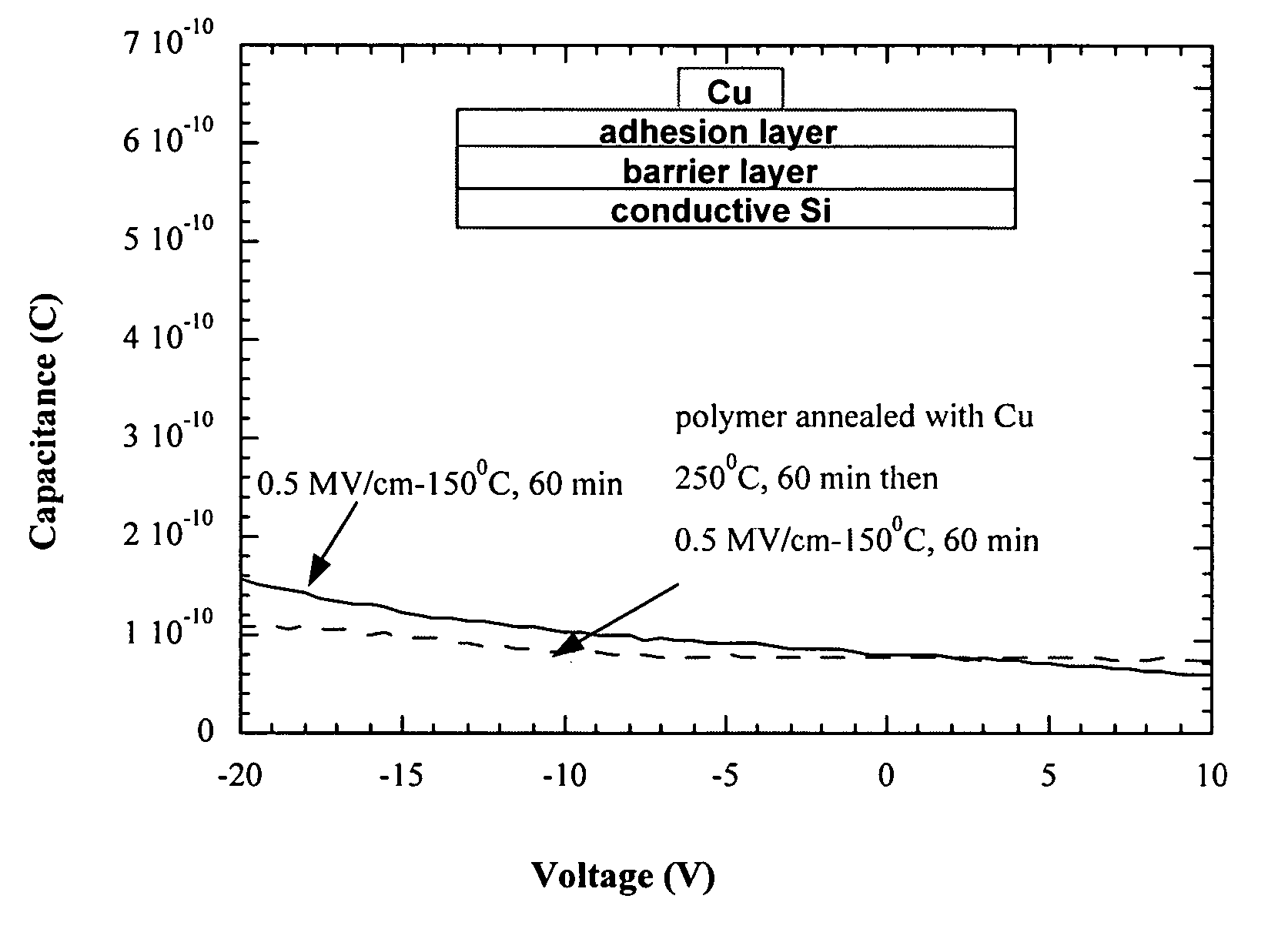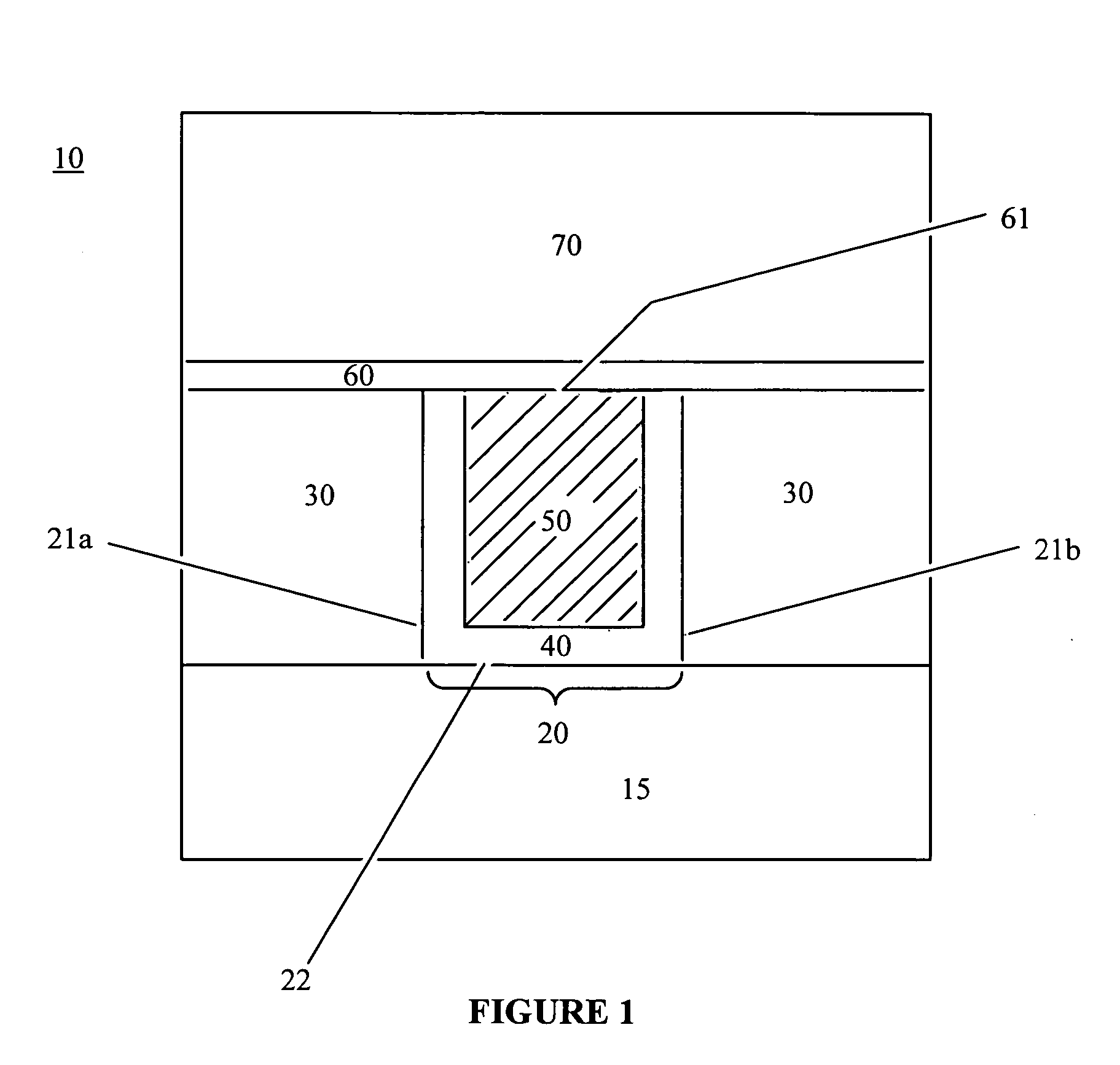Siloxane epoxy polymers as metal diffusion barriers to reduce electromigration
- Summary
- Abstract
- Description
- Claims
- Application Information
AI Technical Summary
Benefits of technology
Problems solved by technology
Method used
Image
Examples
example 1
[0049] N-type, 4-inch silicon wafers having a resistivity of 0-0.02 ohm-cm for MIM (metal-insulator-metal) structures were used as the substrates. After standard RCA cleaning an adhesion layer (HMDS) was spin-coated onto each wafer at 3000 rpm for 40 sec. The wafers were then annealed in air at 100° C. for 10 min. A siloxane epoxy polymer solution containing formula (IIB), wherein the ratio of p to q was about 2:1, was spin-coated onto each wafer at 3000 rpm for 100 sec to a thickness of 0.5 μm. Onto the deposited polymer films, copper metal thin films were deposited to a thickness of 0.3 μm using sputtering or e-beam evaporation. The Cu / polymeric film / wafers were then dried under vacuum of 10−3 torr for 1 hour at 100° C. The samples were then cured at 165° C. for 2 hours to cross-link the polymer, followed by a thermal anneal at 250° C. under nitrogen gas flow for 1 hour. These films passed the industry-accepted Scotch® tape adhesion test, which was executed using commercially avai...
example 2
[0050] The procedure of Example 1 was followed. Then a thin layer of an adhesion promoter was deposited onto the copper surface of each sample. The adhesion promoter was also a siloxane epoxy polymer solution having formula (IIB), wherein the ratio of p to q was about 2:1, and was spin-coated onto the copper films at 3000 rpm for 100 sec to a thickness ranging from about 0.01 μm to about 0.03 μm. The samples were then dried under vacuum of 10−3 torr for 1 hour at 100° C., followed by curing at 165° C. for 2 hours and a thermal annea at 250° C. under nitrogen gas flow for 1 hour to cross-link the polymer. The surface of the polymeric adhesion promoter layer was then contacted with an aqueous solution of sulfuric acid (50% by weight) for 30 seconds at room temperature, followed by removal of the acid solution by rinsing with deionized water for 30 seconds at room temperature and drying. A second layer comprising a siloxane epoxy polymer solution containing formula (IIB), wherein the r...
example 3
[0051] N-type, 4-inch silicon wafers having a resistivity of 0-0.02 ohm-cm for MIM (metal-insulator-metal) structures were used as the substrates. After standard RCA cleaning, an adhesion layer (HMDS) was spin-coated onto each wafer at 3000 rpm for 40 sec. The wafers were then annealed in air at 100° C. for 10 min. A siloxane epoxy polymer solution, acting as a diffusion barrier and containing formula (IIB), wherein the ratio of p to q was about 2:1, was spin-coated onto each wafer at 3000 rpm for 100 sec to a thickness ranging from about 0.02 μm to about 0.05 μm. The polymeric film / wafers were dried under vacuum of 10−3 torr for 1 hour at 100° C. The polymer films were then cured at 165° C. for 2 hours to cross-link the polymer, followed by a thermal anneal at 250° C. under nitrogen gas flow for 1 hour. The surface of the polymeric diffusion barrier was then contacted with an aqueous solution of sulfuric acid (50% by weight) for 30 seconds at room temperature, followed by removal o...
PUM
 Login to View More
Login to View More Abstract
Description
Claims
Application Information
 Login to View More
Login to View More - R&D
- Intellectual Property
- Life Sciences
- Materials
- Tech Scout
- Unparalleled Data Quality
- Higher Quality Content
- 60% Fewer Hallucinations
Browse by: Latest US Patents, China's latest patents, Technical Efficacy Thesaurus, Application Domain, Technology Topic, Popular Technical Reports.
© 2025 PatSnap. All rights reserved.Legal|Privacy policy|Modern Slavery Act Transparency Statement|Sitemap|About US| Contact US: help@patsnap.com



